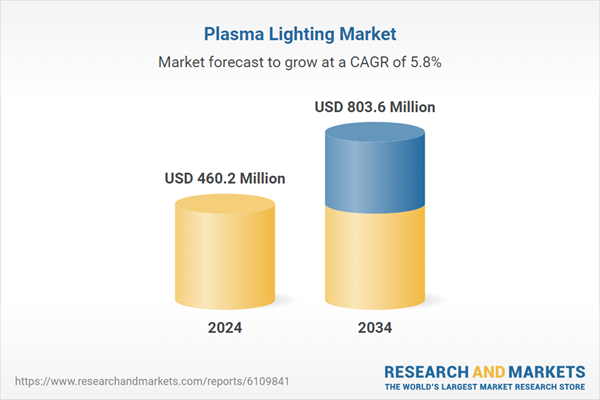Plasma lights produce a broad spectrum of light closely resembling natural sunlight, which promotes healthier plant growth and higher yields. Their long lifespan, energy efficiency, and robust durability make them highly suitable for environments that require consistent, continuous lighting. Meanwhile, industrial and outdoor applications demand lighting solutions that deliver high-lumen output and long operational life under tough conditions. Plasma lighting fits these requirements perfectly due to its high color rendering index (CRI), resistance to shocks, and ability to withstand temperature fluctuations.
Infrastructure modernization and energy-efficient initiatives led by governments are significantly accelerating the transition from traditional metal halide and HID lighting systems to advanced plasma lighting technologies across various sectors. These policy-driven efforts focus on reducing energy consumption and lowering carbon footprints while enhancing lighting quality and durability. As a result, plasma lighting, with its superior energy efficiency, longer lifespan, and better light quality, is becoming the preferred choice for public infrastructure projects.
The electrodeless plasma lamps (LEP) segment held a market value of USD 212.9 million in 2024, dominating the plasma lighting market because of its dependable technology and widespread adoption in municipal and industrial lighting applications. LEP lamps offer a consistent light output and long service life, making them ideal for locations demanding steady, high-intensity illumination. However, their growth faces challenges from increasing operational costs and rising competition from emerging lighting technologies.
The highways, street lighting, and tunnels segment dominated the market in 2024, holding a significant 36.6% share, driven primarily by the surge in infrastructure development projects demanding dependable, high-intensity, and low-maintenance lighting solutions. Public authorities and municipalities favor plasma lighting because of its exceptional longevity and robust performance under tough outdoor conditions, such as in tunnels, bridges, and busy roadways, where both safety and operational cost savings are paramount. This preference is reinforced by plasma lighting’s ability to deliver consistent illumination with minimal maintenance, reducing downtime and replacement costs in critical infrastructure settings.
United States Plasma Lighting Market was valued at USD 107.8 million in 2024, fueled by proactive government investments in modernizing infrastructure alongside widespread applications in industrial and horticultural sectors. The country’s early embrace of cutting-edge lighting technologies has accelerated the integration of plasma lighting into smart city projects and controlled environment agriculture systems. These initiatives emphasize energy efficiency, precise light spectrum control, and long-lasting solutions, further increasing the demand for plasma lighting across diverse applications. The combination of robust infrastructure spending, technological innovation, and sector-specific demand is set to sustain strong growth momentum in the U.S. plasma lighting market over the coming years.
Leading companies in the Plasma Lighting Industry include LG Electronics, Gavita International B.V., and Ushio Inc., which hold significant market positions through continuous innovation and strategic market outreach. To strengthen their market presence and build a competitive edge, companies in the plasma lighting sector focus on multiple strategic initiatives. Innovation plays a central role, with firms investing heavily in developing more energy-efficient, longer-lasting plasma lighting solutions that meet the evolving needs of horticultural and industrial applications. Partnerships and collaborations with agricultural technology providers, infrastructure developers, and municipal authorities allow companies to expand their reach and tailor products to specific client demands. Expanding product portfolios to include smart, controllable lighting systems helps tap into emerging trends like precision agriculture and smart city infrastructure.
Comprehensive Market Analysis and Forecast
- Industry trends, key growth drivers, challenges, future opportunities, and regulatory landscape
- Competitive landscape with Porter’s Five Forces and PESTEL analysis
- Market size, segmentation, and regional forecasts
- In-depth company profiles, business strategies, financial insights, and SWOT analysis
This product will be delivered within 2-4 business days.
Table of Contents
Companies Mentioned
- Alphalite Inc.
- Gavita International B.V.
- Green De Corp
- Hive Lighting
- LG Electronics
- Lumartix SA.
- pinkRF
- Plasma International GmbH
- PlasmaBright
- Ushio Inc.
- WAVEPIA CO., LTD.
- Solaronix SA
Table Information
| Report Attribute | Details |
|---|---|
| No. of Pages | 150 |
| Published | June 2025 |
| Forecast Period | 2024 - 2034 |
| Estimated Market Value ( USD | $ 460.2 Million |
| Forecasted Market Value ( USD | $ 803.6 Million |
| Compound Annual Growth Rate | 5.8% |
| Regions Covered | Global |
| No. of Companies Mentioned | 12 |









